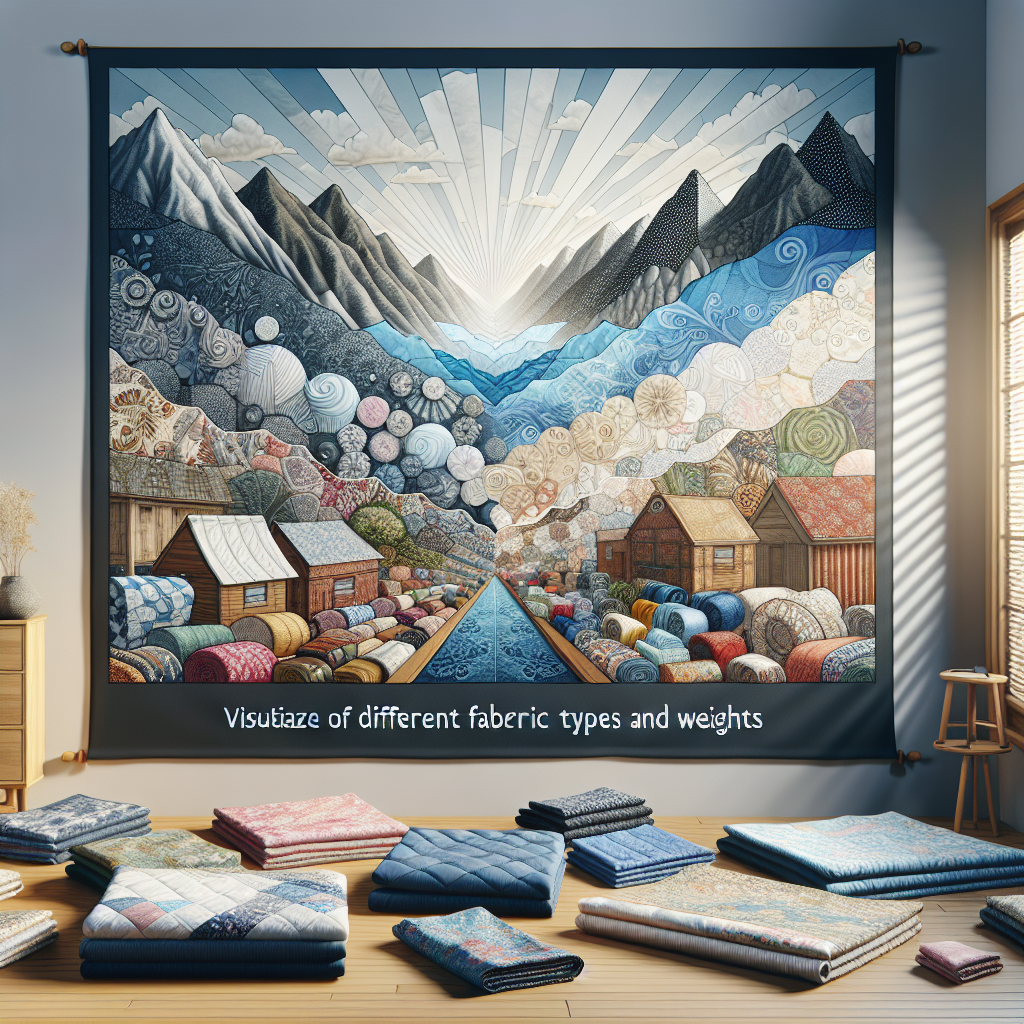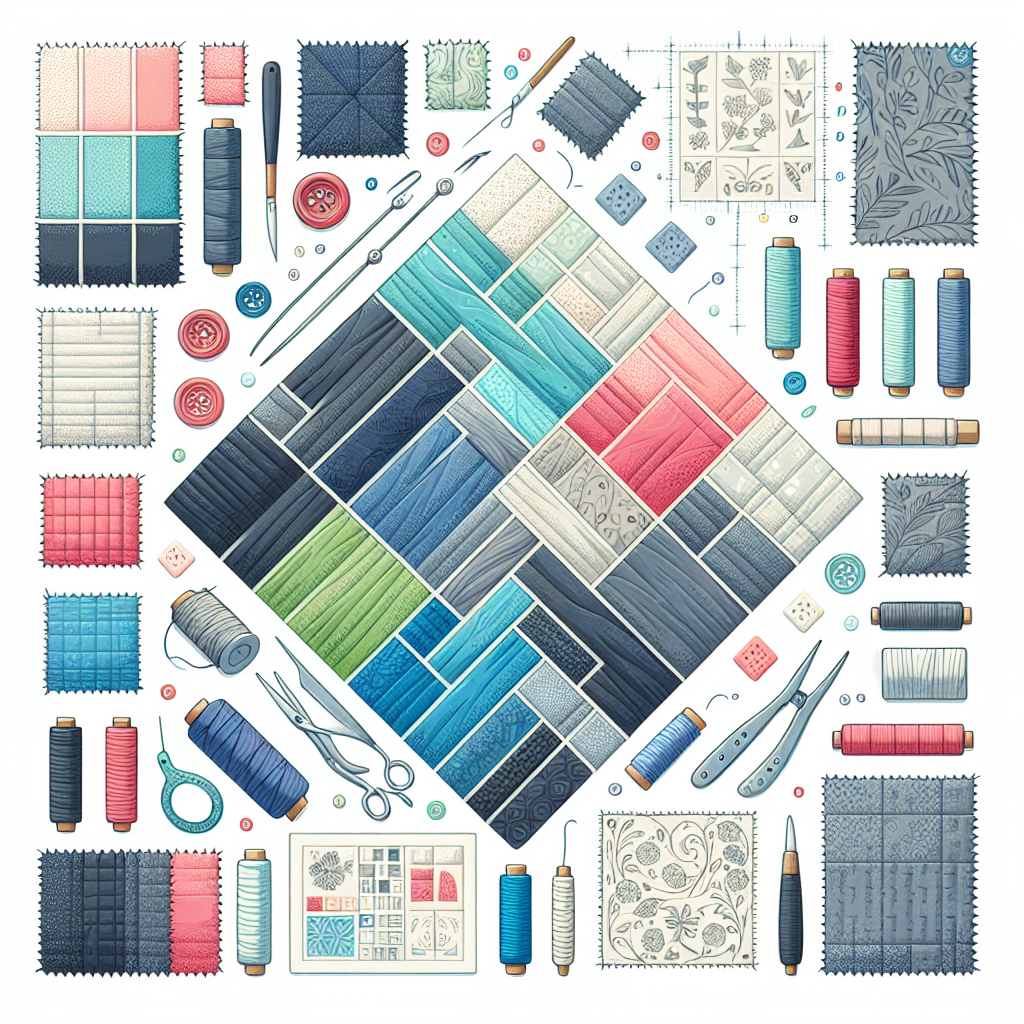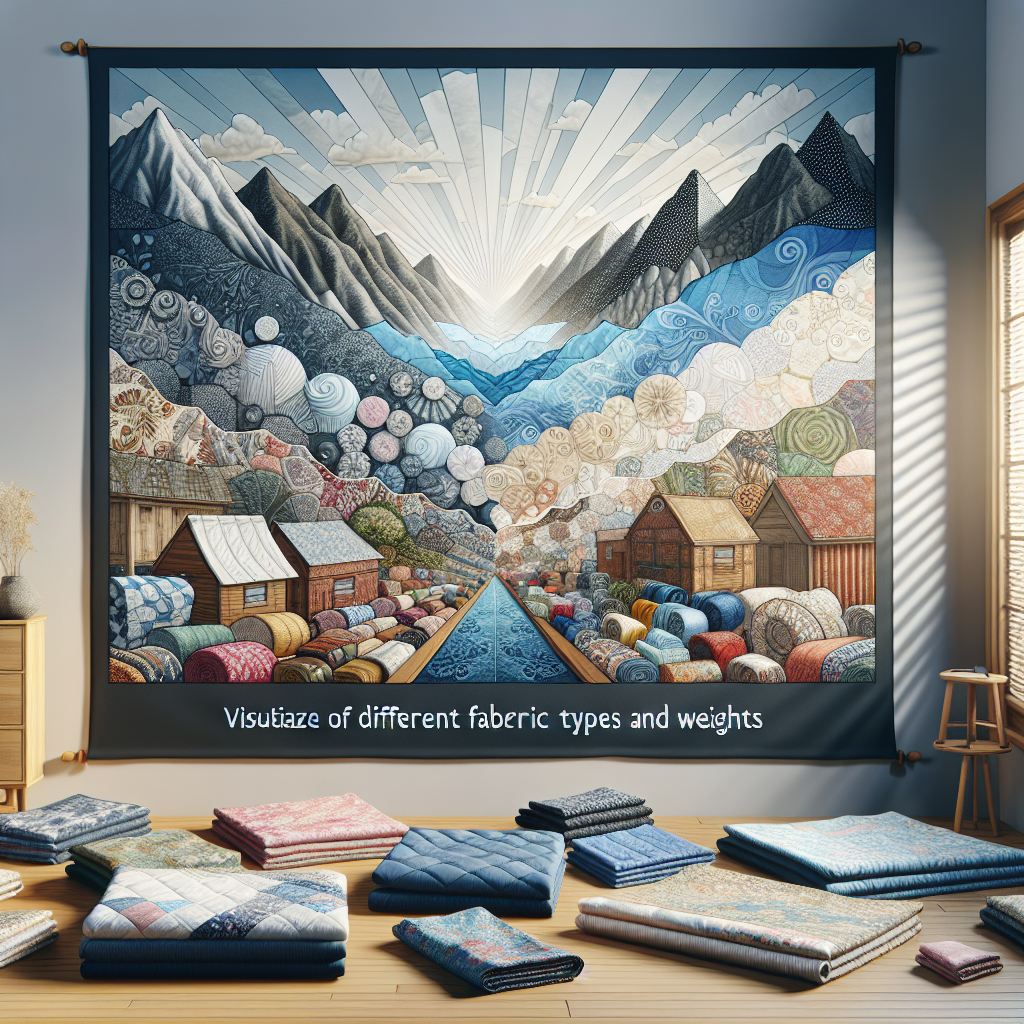Ever wondered how the type and weight of fabric can make a difference in the outcome of your quilt? Well, look no further! In this article, we will explore the fascinating world of quilting and delve into the impact that fabric types and weights can have on the overall look and feel of your finished masterpiece. Whether you prefer lightweight cotton or cozy flannel, understanding how different fabrics behave can help you create a quilt that is not only visually stunning but also durable and functional. So, grab your favorite quilt pattern and get ready to embark on a journey of discovery as we uncover the secrets behind fabric types and weights in quilting. It’s time to unleash your inner quilt artist!
Understanding Fabric Types
When it comes to selecting the right fabric for your quilting projects, it’s important to understand the different types and their characteristics. Fabrics can be categorized into three main types: natural fabrics, synthetic fabrics, and blended fabrics. Each type has its own unique properties that affect how it feels, behaves, and looks in a quilt.
Natural Fabrics
Natural fabrics are made from fibers that occur in nature, such as plants or animals. These fabrics are known for their breathability, softness, and comfort. They can absorb moisture well and tend to have a natural feel to them. Some common types of natural fabrics used in quilting include cotton, linen, silk, and wool.
Synthetic Fabrics
Synthetic fabrics are made from man-made materials, typically polymers derived from petroleum. These fabrics are known for their durability, affordability, and resistance to wrinkles. They are often used in quilting due to their wide availability and ability to retain vibrant colors. Common synthetic fabrics used in quilting include polyester, nylon, acrylic, and rayon.
Blended Fabrics
Blended fabrics are a combination of natural and synthetic fibers. These fabrics offer the benefits of both types, such as the softness and breathability of natural fabrics, along with the durability and wrinkle resistance of synthetic fabrics. Blended fabrics can be a good choice for quilting projects that require the best of both worlds.
Effects of Fabric Types
The fabric type you choose for your quilt can have various effects on its performance and appearance. Here are some key factors to consider:
Breathability
Breathability refers to the fabric’s ability to allow air to pass through, which helps regulate body temperature. Natural fabrics like cotton and linen are highly breathable, making them ideal for warm climates or quilts used in the summer. Synthetic fabrics tend to be less breathable but can still offer some airflow depending on their construction.
Durability
The durability of a fabric is an important consideration, especially for quilts that will be subjected to regular use and washing. Natural fabrics like silk and wool are known for their strength and durability, although they may require extra care during laundering. Synthetic fabrics like polyester and nylon are generally more durable and resistant to wear and tear.
Absorbency
The absorbency of a fabric refers to its ability to soak up moisture. Natural fabrics like cotton and linen are highly absorbent, making them suitable for quilts that need to wick away sweat or moisture. Synthetic fabrics tend to be less absorbent, which can be an advantage in some cases, such as quilts used outdoors or in humid environments.
Texture
The texture of a fabric refers to its physical feel and surface characteristics. Natural fabrics like silk and wool often have a smooth and luxurious texture, while cotton and linen can have a slightly rougher texture. Synthetic fabrics can vary widely in texture, ranging from smooth and silky to coarse and stiff.
Shrinkage
Shrinkage is a consideration when choosing fabrics for quilting, as it can affect the overall size and appearance of the finished quilt. Natural fabrics like cotton and linen may shrink to some extent when washed, while synthetic fabrics are generally more resistant to shrinkage. It’s important to prewash and preshrink fabrics before beginning a quilting project to minimize any potential shrinkage issues.

Considering Fabric Weights
Fabric weight refers to the thickness and density of the fabric. Understanding different fabric weights is crucial for selecting the right fabric for your quilt, as it can affect its warmth, drape, strength, and ease of sewing.
Lightweight Fabrics
Lightweight fabrics are thin and often have a loose weave, which allows air to pass through easily. These fabrics are ideal for quilts used in warmer climates or during the summer months. They have a light and airy feel, making them comfortable and breathable. However, lightweight fabrics may not offer the same level of durability as heavier fabrics.
Medium-weight Fabrics
Medium-weight fabrics strike a balance between lightness and heaviness. They have a moderate thickness and density, making them suitable for a wide range of quilting projects. Medium-weight fabrics provide good warmth and drape, while still maintaining a comfortable feel. They are often chosen for quilts that need to be versatile and adaptable to different climates.
Heavyweight Fabrics
Heavyweight fabrics are thick, dense, and often have a tight weave. These fabrics offer excellent insulation and provide substantial warmth and coziness to quilts. They are ideal for quilts used in colder climates or during the winter season. However, heavyweight fabrics can be more challenging to work with due to their weight and stiffness.
Impact of Fabric Weights
The fabric weight you choose can have a significant impact on the overall characteristics and performance of your quilt. Here are some key factors to consider:
Warmth
The weight of the fabric directly affects its insulating properties, which determine the warmth of the quilt. Lightweight fabrics provide less insulation and are suitable for summer quilts or quilts used in warmer climates. Medium-weight fabrics offer moderate warmth and versatility. Heavyweight fabrics provide excellent insulation and are ideal for colder climates or quilts used in chilly environments.
Drape
Drape refers to how a fabric hangs or falls when used in a quilt. Lightweight fabrics generally have a soft and flowing drape, while heavyweight fabrics tend to be more structured and stiff. The desired drape will depend on your personal preference and the overall aesthetic you want to achieve in your quilt.
Strength
The weight of the fabric can also affect its strength and durability. Heavyweight fabrics tend to be more sturdy and resistant to wear and tear, making them suitable for quilts that need to withstand frequent use and laundering. Lightweight fabrics may be more prone to fraying or tearing, so extra care should be taken during the quilting process.
Ease of Sewing
Sewing with different fabric weights can present its own set of challenges. Lightweight fabrics may require special techniques to prevent shifting or distortion during sewing, while heavyweight fabrics may require stronger needles and more effort to manipulate. Medium-weight fabrics are generally easier to work with and can be a good option for beginners or those looking for a balance between ease of sewing and desired quilt characteristics.

Natural Fabrics
Natural fabrics are derived from organic sources such as plants or animals. They are known for their breathable, comfortable, and environmentally-friendly properties. Here are some common natural fabrics used in quilting:
Cotton
Cotton is one of the most widely used fabrics in quilting. It is highly breathable, soft, and comfortable to wear and touch. Cotton quilts provide excellent airflow, making them suitable for warmer climates. Cotton is also known for its good absorbency, which makes it ideal for quilts that need to wick away moisture. However, cotton is prone to wrinkles and may shrink to some extent when washed.
Linen
Linen is a natural fabric made from the fibers of the flax plant. It is highly breathable and offers excellent airflow, making it ideal for quilts used in hot climates or during the summer months. Linen has a cool and fresh feel against the skin and offers good durability. However, linen tends to be stiff and wrinkles easily. It also has little to no stretch, which can affect its suitability for certain quilt designs.
Silk
Silk is a luxurious natural fabric known for its smooth and lustrous texture. It has excellent breathability and provides a soft and comfortable feel against the skin. Silk quilts have a luxurious and elegant appearance and can be lightweight or heavyweight depending on the specific type of silk used. However, silk is more delicate and requires extra care during laundering.
Wool
Wool is a natural fabric made from the fibers of sheep or other animals. It is highly breathable, insulating, and provides excellent warmth. Wool quilts are suitable for colder climates or for those who prefer extra coziness. Wool is also naturally flame-resistant and offers good durability. However, wool can be more challenging to work with due to its thickness and potential for shedding.
Synthetic Fabrics
Synthetic fabrics are man-made materials created through chemical processes. They offer a range of benefits such as durability, affordability, and resistance to wrinkles. Here are some common synthetic fabrics used in quilting:
Polyester
Polyester is a synthetic fabric known for its durability and resistance to wrinkles. It is easy to care for, retains its shape well, and is resistant to mildew and moths. Polyester quilts are often machine washable and dry quickly. Polyester is also available in a wide range of colors and prints, making it a popular choice for quilting projects.
Nylon
Nylon is a synthetic fabric known for its strength and durability. It is resistant to abrasion, making it suitable for quilts that will be subjected to frequent use or heavy wear. Nylon is also lightweight and quick-drying, making it a good choice for outdoor or sports-themed quilts. However, nylon may not be as breathable as natural fabrics and can retain heat in warm environments.
Acrylic
Acrylic is a synthetic fabric known for its softness and warmth. It is often used as a substitute for wool in quilting projects, offering similar insulating properties without the potential for allergies. Acrylic quilts are usually lightweight and easy to care for, as they are machine washable and resistant to wrinkling. However, acrylic may not have the same luxurious feel as natural fabrics.
Rayon
Rayon is a semi-synthetic fabric made from natural cellulose fibers, often derived from wood pulp. It combines the properties of natural and synthetic fabrics, offering a good balance of breathability, softness, and durability. Rayon quilts have a smooth and silky feel, making them suitable for quilts with a more elegant and luxurious appearance.
Blended Fabrics
Blended fabrics combine the properties of natural and synthetic fibers, offering the benefits of both types. Common fabric combinations in quilting include:
Cotton and Polyester Blends
Cotton and polyester blends offer the softness and breathability of cotton with the durability and wrinkle resistance of polyester. These blends are commonly used in quilting, providing a comfortable and easy-to-care-for option. Cotton and polyester blends are often machine washable and resist shrinking.
Cotton and Silk
Cotton and silk blends combine the natural feel and comfort of cotton with the luxurious and lustrous appearance of silk. These blends offer a soft and breathable fabric that adds elegance to quilting projects. However, cotton and silk blends may require extra care during laundering to maintain their texture and appearance.
Linen and Rayon
Linen and rayon blends combine the breathability and natural feel of linen with the softness and durability of rayon. These blends offer a comfortable and versatile fabric for quilting, suitable for a wide range of climates and quilt designs. Linen and rayon blends may require special care during laundering to prevent wrinkles.
Wool and Nylon
Wool and nylon blends combine the warmth and insulating properties of wool with the strength and durability of nylon. These blends are ideal for quilts that need to withstand heavy use or frequent washing. Wool and nylon blends provide excellent warmth and durability, making them suitable for colder climates or winter quilts.
In conclusion, understanding fabric types and weights is crucial for choosing the right materials for your quilting projects. Natural fabrics like cotton, linen, silk, and wool offer breathability, comfort, and a variety of textures. Synthetic fabrics like polyester, nylon, acrylic, and rayon provide durability, affordability, and resistance to wrinkles. Blended fabrics combine the best of both worlds, offering a balance of natural and synthetic properties. Considering fabric weights, such as lightweight, medium-weight, and heavyweight, also plays a key role in determining warmth, drape, strength, and ease of sewing in your quilts. By considering these factors, you can make informed decisions and create quilts that not only look beautiful but also perform well and stand the test of time. Happy quilting!
